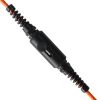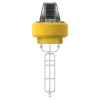NexSens T-Node FR Thermistor String
Features
- Build multi-point temperature strings by connecting T-Nodes to underwater cables
- +/- 0.075 C accuracy for precision temperature measurements
- Includes sensorBUS for connecting other smart sensors
- Free ground shipping
- Expedited repair and warranty service
- Lifetime technical support
- More
The NexSens T-Node FR Thermistor String provides high accuracy temperature data in a connectorized and addressable architecture for water quality profiling. Each node features an integral titanium thermistor secured and epoxied in a protective housing for underwater deployments. The nodes are connected in-series using marine-grade UW Cables with braided Kevlar core and double O-ring seals.
Each T-Node FR sensor is accurate to +/-0.075 C for high-precision measurements. The exposed titanium thermistor makes direct contact with water, allowing readings to stabilize within 60 seconds. Temperature data is transmitted on a RS-485 Modbus RTU string bus for integration with data loggers and SCADA systems. The string is powered by 4-28 VDC for operation on a 12 or 24 VDC power supply.
Mating UW Cables are available in lengths from 0.5m to 50m with a maximum 1,219 meters (4,000 feet) or 250 nodes. Strings terminate in a NexSens UW plug and receptacle connector, allowing additional sections or sensors to be added as required. Optional accessories include water quality sensors, pressure sensors, signal splitters, cable clamps, stainless steel mooring line, and communication adapters.
- Sensor: Thermistor
- Range: 0 to 45 C (32 to 113 F)
- Accuracy: +/-0.075 C
- Resolution: 0.01 C
- T90 Response Time: 60 seconds
- Refresh Rate: 2 seconds
- Maximum Sensors: 250
- Maximum Length: 1219m (4000 ft.)
- Maximum Depth: 200m (656 ft.)
- Communications: RS-485 Modbus RTU
- Power Requirement: 4-28 VDC
- Current Draw Per Node: 1.3mA active; 0.35mA sleep; 0.05mA deep sleep
- Connection Seal: Double o-ring, gland and face seal
- Connector: 8 pin, sensorBUS
- Dimensions: 13.46cm L x 3.56cm Dia. (5.3" L x 1.4" Dia.)
In The News
Climate Change Asymmetry Transforming Food Webs
Recent research from a University of Guelph (U of G) team reveals that warmer temperatures caused by climate change are forcing species to alter their behavior, causing food webs in Ontario lakes to transform. As temperatures warm, larger species hunt new prey in deeper waters, changing the ways nutrients and energy flow in lakes and triggering a “rewiring” of food webs. Dr. Timothy Bartley , study lead author and a post-doctoral researcher in the U of G's Department of Integrative Biology , spoke to EM about the work . “I got started on this when I first began graduate school and joined an ongoing project, which was a collaboration with the Ontario Ministry of Natural Resources and Forestry ,” explains Dr. Bartley.
Read MoreLake Superior Weather Buoy Provides Valuable New Data
A new weather buoy in a remote part of Lake Superior is providing much-needed weather data to local mariners, the National Weather Service and researchers. Scientists from the Superior Watershed Partnership (SWP), Lentic Environmental Services (LES) and the University of Colorado-Boulder recently deployed the buoy on the lake one mile north of Stannard Rock Lighthouse. SWP gained ownership of the lighthouse in 2015. Because the light was built on a large reef in a remote part of the lake, it is one of the most popular trout fishing and charter boat destinations on the Great Lakes. It has also been the location of a NOAA weather station since 1984 and a Great Lakes Evaporation Network monitoring site since 2008.
Read MoreLake Nipissing Algae Blooms: Mixing May Have Role
Sitting between the Ottawa River and Georgian Bay, Lake Nipissing is the third largest lake in Ontario. It’s packed full of islands and has shallow waters that make for numerous sandbars along a winding shoreline. The lake is a popular tourist draw, especially around Callander Bay, where boaters and swimmers come in the summer and anglers fish year-round. Despite that, the nutrients that support algae growth in the bay have been largely unstudied. Researchers at the University of Saskatchewan and Nipissing University are trying to relieve that lack of knowledge with the help of two data buoys. One is deployed in the center of Callander Bay while the other is sitting between the Manitou Islands and the City of North Bay.
Read More





































